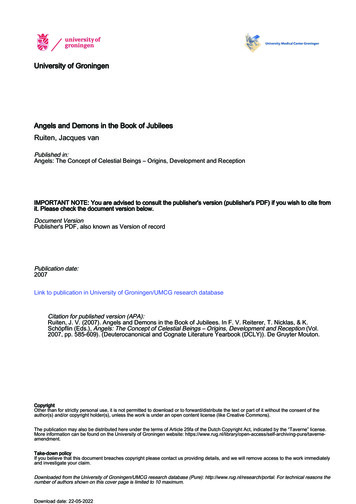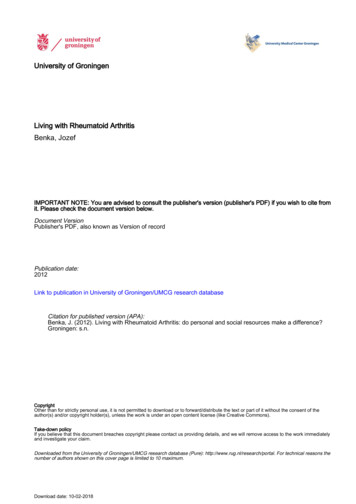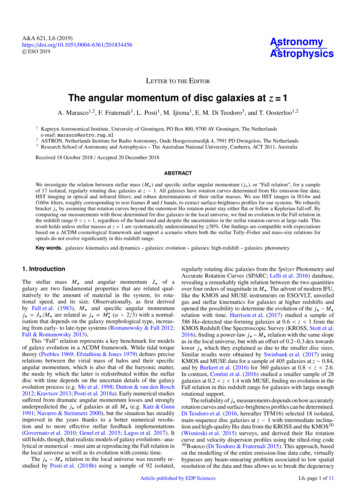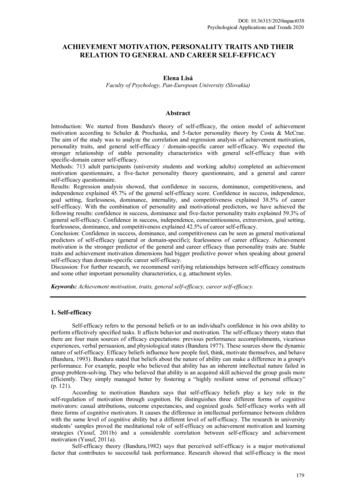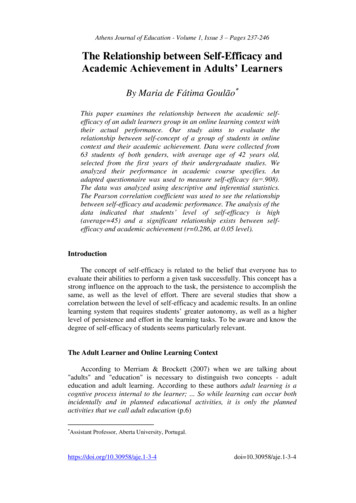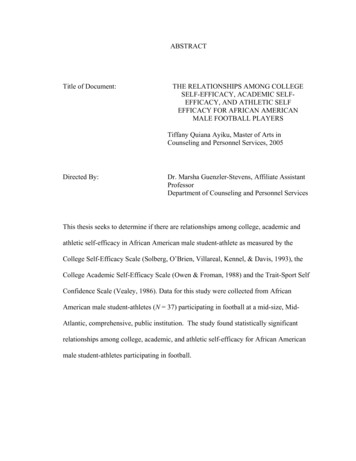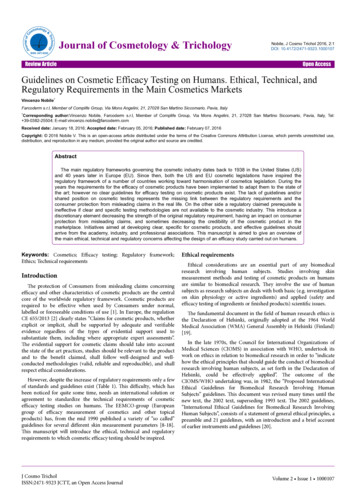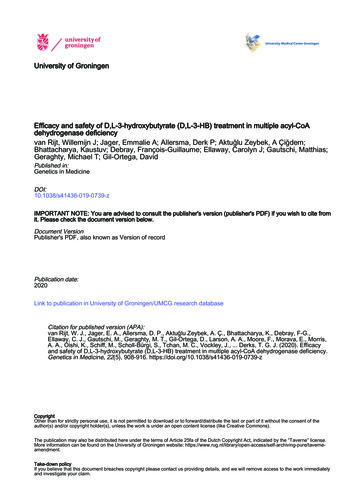
Transcription
University of GroningenEfficacy and safety of D,L-3-hydroxybutyrate (D,L-3-HB) treatment in multiple acyl-CoAdehydrogenase deficiencyvan Rijt, Willemijn J; Jager, Emmalie A; Allersma, Derk P; Aktuğlu Zeybek, A Çiğdem;Bhattacharya, Kaustuv; Debray, François-Guillaume; Ellaway, Carolyn J; Gautschi, Matthias;Geraghty, Michael T; Gil-Ortega, DavidPublished in:Genetics in MedicineDOI:10.1038/s41436-019-0739-zIMPORTANT NOTE: You are advised to consult the publisher's version (publisher's PDF) if you wish to cite fromit. Please check the document version below.Document VersionPublisher's PDF, also known as Version of recordPublication date:2020Link to publication in University of Groningen/UMCG research databaseCitation for published version (APA):van Rijt, W. J., Jager, E. A., Allersma, D. P., Aktuğlu Zeybek, A. Ç., Bhattacharya, K., Debray, F-G.,Ellaway, C. J., Gautschi, M., Geraghty, M. T., Gil-Ortega, D., Larson, A. A., Moore, F., Morava, E., Morris,A. A., Oishi, K., Schiff, M., Scholl-Bürgi, S., Tchan, M. C., Vockley, J., . Derks, T. G. J. (2020). Efficacyand safety of D,L-3-hydroxybutyrate (D,L-3-HB) treatment in multiple acyl-CoA dehydrogenase deficiency.Genetics in Medicine, 22(5), 908-916. Other than for strictly personal use, it is not permitted to download or to forward/distribute the text or part of it without the consent of theauthor(s) and/or copyright holder(s), unless the work is under an open content license (like Creative Commons).The publication may also be distributed here under the terms of Article 25fa of the Dutch Copyright Act, indicated by the “Taverne” license.More information can be found on the University of Groningen website: ing-pure/taverneamendment.Take-down policyIf you believe that this document breaches copyright please contact us providing details, and we will remove access to the work immediatelyand investigate your claim.
ARTICLEEfficacy and safety of D,L-3-hydroxybutyrate (D,L-3-HB)treatment in multiple acyl-CoA dehydrogenase deficiencyWillemijn J. van Rijt, MD1, Emmalie A. Jager, BSc1, Derk P. Allersma, PhD2,A. Çiğdem Aktuğlu Zeybek, MD3, Kaustuv Bhattacharya, MD, PhD4,François-Guillaume Debray, MD, PhD5, Carolyn J. Ellaway, MBBS, PhD4, Matthias Gautschi, MD, PhD6,Michael T. Geraghty, MD PhD7, David Gil-Ortega, MD, PhD8, Austin A. Larson, MD9,Francesca Moore, BSc10, Eva Morava, MD, PhD11,12, Andrew A. Morris, MD, PhD13,14,Kimihiko Oishi, MD15, Manuel Schiff, MD, PhD16, Sabine Scholl-Bürgi, MD, PhD17,Michel C. Tchan, MD, PhD18, Jerry Vockley, MD, PhD19, Peter Witters, MD, PhD12,Saskia B. Wortmann, MD, PhD20,21,22, Francjan van Spronsen, MD, PhD1,Johan L. K. Van Hove, MD, PhD9 and Terry G. J. Derks, MD, PhD 1Purpose: Multiple acyl-CoA dehydrogenase deficiency (MADD) isa life-threatening, ultrarare inborn error of metabolism. Casereports described successful D,L-3-hydroxybutyrate (D,L-3-HB)treatment in severely affected MADD patients, but systematic dataon efficacy and safety is lacking.Methods: A systematic literature review and an international,retrospective cohort study on clinical presentation, D,L-3-HBtreatment method, and outcome in MADD(-like) patients.Results: Our study summarizes 23 MADD(-like) patients, including 14 new cases. Median age at clinical onset was two months(interquartile range [IQR]: 8 months). Median age at starting D,L-3HB was seven months (IQR: 4.5 years). D,L-3-HB doses rangedbetween 100 and 2600 mg/kg/day. Clinical improvement wasreported in 16 patients (70%) for cardiomyopathy, leukodystrophy,liver symptoms, muscle symptoms, and/or respiratory failure. D,L3-HB appeared not effective for neuropathy. Survival appearedINTRODUCTIONMultiple acyl-CoA dehydrogenase deficiency (MADD; alsoknown as glutaric aciduria type II, OMIM 231680) is anultrarare (i.e., 1:50,000) inborn error of metabolism (IEM).MADD can be primary, caused by a genetic defect in thelonger upon D,L-3-HB compared with historical controls. Mediantime until first clinical improvement was one month, and ranged upto six months. Reported side effects included abdominal pain,constipation, dehydration, diarrhea, and vomiting/nausea. MedianD,L-3-HB treatment duration was two years (IQR: 6 years). D,L-3HB treatment was discontinued in 12 patients (52%).Conclusion: The strength of the current study is the internationalpooling of data demonstrating that D,L-3-HB treatment can beeffective and safe in MADD(-like) patients.Genetics in Medicine (2020) https://doi.org/10.1038/s41436-0190739-zKeywords: D,L-3-hydroxybutyrate treatment; fatty acid oxidation; inborn error of metabolism; ketone bodies; multiple acyl-CoAdehydrogenase deficiencyelectron transfer flavoproteins (ETF) or in ETF dehydrogenase (ETFDH), or secondary, resulting from genetic defects ofriboflavin transport (RFVT) or flavin adenine dinucleotide(FAD) synthesis (i.e., MADD-like disease). The impairmentof mitochondrial fatty acid oxidation (FAO) and amino acid1Section of Metabolic Diseases, University of Groningen, University Medical Center Groningen, Beatrix Children’s Hospital, Groningen, The Netherlands; 2Department of ClinicalPharmacy and Pharmacology, University of Groningen, University Medical Center Groningen, Groningen, The Netherlands; 3Division of Nutrition and Metabolism, Department ofPediatrics, Cerrahpasa Medical Faculty, Istanbul University-Cerrahpasa, Istanbul, Turkey; 4Genetic Metabolic Disorders Service, Sydney Children’s Hospital Network, Disciplines ofGenetic Medicine and Child and Adolescent Health, University of Sydney, Sydney, Australia; 5Department of Medical Genetics, CHU of Liège, Liège, Belgium; 6University HospitalBern, Department of Pediatric Endocrinology, Diabetology and Metabolism and University Institute of Clinical Chemistry, Inselspital, University of Bern, Bern, Switzerland;7Division of Metabolics and Newborn Screening, Department of Pediatrics, Children’s Hospital of Eastern Ontario, Ottawa, ON, Canada; 8Department of PediatricGastroenterology, Hospital Universitario Virgen de la Arrixaca, Murcia, Spain; 9Section of Clinical Genetics and Metabolism, Department of Pediatrics, University of Colorado,Aurora, CO, USA; 10Biochemical Genetics Laboratory, The Children’s Hospital at Westmead, Sydney, Australia; 11Center of Individualized Medicine, Department of ClinicalGenomics, Mayo Clinic, Rochester, MN, USA; 12Metabolic Disease Center, University Hospitals Leuven, Leuven, Belgium; 13Manchester Centre for Genomic Medicine, St Mary’sHospital, Central Manchester University Hospitals NHS Foundation Trust, Manchester Academic Health Sciences Centre, Manchester, United Kingdom; 14Division of Evolutionand Genomic Sciences, School of Biological Sciences, University of Manchester, Manchester, United Kingdom; 15Department of Genetics and Genomic Sciences, Icahn School ofMedicine at Mount Sinai, New York, NY, USA; 16Reference Centre for Inborn Errors of Metabolism, Robert Debré Univ. Hospital, APHP, INSERM U1141 and Paris DiderotUniversity, Paris, France; 17Department of Pediatrics I, Inherited Metabolic Disorders, Medical University of Innsbruck, Innsbruck, Austria; 18Westmead Hospital, University ofSydney, Sydney, Australia; 19Department of Pediatrics, Children’s Hospital of Pittsburgh of UPMC, Pittsburgh, PA, USA; 20University Childrens Hospital, Paracelcus MedicalUniversity (PMU), Salzburg, Austria; 21Institute of Human Genetics, Helmholtz Zentrum München, Neuherberg, Germany; 22Institute of Human Genetics, Technische UniversitätMünchen, Munich, Germany. Correspondence: Terry G. J. Derks (t.g.j.derks@umcg.nl)Submitted 19 August 2019; accepted: 18 December 2019GENETICS in MEDICINE Volume 0 Number 0 Month1
1234567890():,;ARTICLEmetabolism causes energy deficiency and the accumulation oftoxic metabolites, such as medium-chain and long-chainlength plasma acylcarnitines, urinary organic acids (e.g.,isovaleric-, isobutyric-, 2-methylbutyric-, glutaric-, ethylmalonic-, 3-hydroxyisovaleric-, 2-hydroxyglutaric-, 5-hydroxyhexanoic-, and several dicarboxylic acids) and urinaryacylglycines (e.g., isovalerylglycine, isobutyrylglycine, and 2methylbutyrylglycine).1Historically, MADD patients are classified into threecategories: patients with a severe, neonatal onset with orwithout congenital anomalies (type I or II, respectively), andpatients with a relatively mild, later onset (type III).1 Type Iand II patients often demonstrate life-threatening symptomsincluding metabolic derangements, cardiomyopathy, leukodystrophy, and severe hypotonia. The clinical course in typeIII patients can vary from recurrent hypoglycemia to lipidstorage myopathy and exercise intolerance.1 Treatmentoptions include dietary fat and protein restriction, fastingavoidance, and supplementation with carnitine, glycine, and/or riboflavin, when riboflavin responsive. Despite earlydiagnosis and treatment, morbidity and mortality remainhigh in neonatal onset patients.1Upon prolonged fasting, hepatic mitochondrial FAO fuelssynthesis of ketone bodies (KB) acetoacetate and 3-hydroxybutyrate, as important alternative energy sources for thebrain, skeletal muscle, and heart.2–4 Patients with mitochondrial FAO disorders, such as MADD, demonstrate multiorgandysfunction especially during catabolism.2 Administration ofexogenous KB might bypass the disturbed ketogenesis. Severalcase reports described successful treatment of severely affectedMADD patients with racemic D,L-3-hydroxybutyrate (D,L-3HB).5–9 The lack of systematic data on efficacy and safety of D,L-3-HB hampers the treatment of seriously ill patients andprevents D,L-3-HB reimbursement. Therefore, we performed atwofold study including a systematic literature review and aninternational, retrospective cohort study to describe the clinicalpresentations of MADD(-like) patients treated with D,L-3-HB,the details of D,L-3-HB treatment methods, and outcomes.MATERIALS AND METHODSThe Medical Ethical Committee of the University MedicalCenter Groningen confirmed that the Medical ResearchInvolving Human Subjects Act does not apply and thatofficial approval of this study by the Medical EthicalCommittee was not required (METc code 2016/470). Thestudy protocol was performed in compliance with theDeclaration of Helsinki and approved for waiver of consentby all participating institutes or performed conforming to thelaws and regulations of the respective countries and institutes.Systematic literature reviewTo identify all reported IEM patients treated with D,L-3-HBand their health-care providers, a comprehensive searchstrategy for relevant publications before 21 December 2016was performed in PubMed and EMBASE public databases.Preferred Reporting Items for Systematic Reviews and Meta2RIJT et alAnalyses (PRISMA) guidelines were followed as accurately aspossible. The detailed search strategy, a protocol of thescreening process and data extraction, a flowchart, and thePRISMA-P 2015 checklist are presented in SupplementaryData 1. Articles were included based on the presence ofdetailed patient data concerning D,L-3-HB- or KB treatment,as well as a confirmed diagnosis by biochemical (acylcarnitineor urinary organic acid profile), DNA, or enzymatic analysis.Exclusion criteria were (1) no detailed patient data described,(2) lack of accessibility of the abstracts or articles, and (3) noavailability in English or Dutch language.Retrospective cohort studyIn February 2017 health-care providers with experience in D,L-3-HB treatment of MADD(-like) patients were invited tocollaborate in this study by contacting (1) the first and/orcorresponding authors of previous publications, identified inour systematic literature study; (2) clinicians who havepreviously contacted the authors (J.L.K.V.H. or T.G.J.D.) onthis topic; (3) several professional organizations and networks, including a list server for the metabolic community(Metab-l), Society for the Study of Inborn Errors ofMetabolism (SSIEM), Society for Inherited Metabolic Disorders (SIMD), and the European Reference Network forHereditary Metabolic Diseases (MetabERN).D,L-3-HB treatment has been reported in at least twoMADD-like patients who were later found to have RFVTdefects.10,11 Patients with genetic defects of RFVT (i.e.,SLC52A1, SLC52A2, SLC52A3 [alias C20orf54]) and FADmetabolism (i.e., SLC25A32, FLAD1) were, therefore, includedin this study in addition to those with ETF or ETFdehydrogenase defects. MADD(-like) patients were eligiblefor enrollment in case of a diagnosis confirmed bybiochemical, DNA, or enzymatic analysis, performed conforming to local protocols. Outcome parameters included dataon clinical presentation, laboratory and molecular parameters,D,L-3-HB treatment method, and (long-term) outcome. Datawas collected via an anonymous questionnaire in MicrosoftWord to be completed by health-care providers involved.Data inclusion was concluded in December 2018, after whichdata from all completed questionnaires were summarized.The STROBE checklist for reporting observational studies ispresented in Supplementary Data 2.Statistical analysisData analysis was performed using Microsoft Excel andGraphPad Prism, version 5.0 (GraphPad Software, La Jolla,CA). Descriptive statistics were used to summarize the data.Categorical and continuous variables are presented asnumbers (percentages) or median (interquartile range[IQR]), respectively. Kaplan–Meier plots were used toestimate the survival and visualize the data on time until firstreported clinical improvement and D,L-3-HB treatmentduration. The survival of MADD(-like) patients treated withD,L-3-HB was compared with survival data from historicalcontrols who were not reported to have been treated with D,Volume 0 Number 0 Month GENETICS in MEDICINE
ARTICLERIJT et alL-3-HB, as collected in a previous meta-analysis.12Mann–Whitney U test was used to analyze the significanceof differences between groups. If data were missing, theanalysis was performed on data from the remaining patients.A p value of 0.05 was considered statistically significant.RESULTSSystematic literature reviewSupplementary Table 1 summarizes data from 14 referenceson D,L-3-HB treatment in 16 patients with MADD(-like)disease.2,5–8,10,11,13–19 Additionally, D,L-3-HB treatment wasreported in 18 patients with other IEMs in which ketogenesisis disturbed, demonstrating potential indications of thecompound. These IEMs included carnitine–acylcarnitinetranslocase deficiency (n 1),17,18 glycogen storage diseasetype III (n 3),20,21 3-hydroxy-3-methylglutaryl-coenzyme Alyase deficiency (n 4),17,18,22,23 mitochondrial complex IVdeficiency (n 2),20 persistent hyperinsulinemic hypoglycemia of infancy (n 6),24,25 propionic acidemia (n 1),20 andvery long-chain acyl-CoA dehydrogenase deficiency (n 1).20Retrospective cohort studyPatient characteristicsIn total, 23 MADD(-like) patients treated with D,L-3-HBtreatment were identified, including 14 novel cases. Theindividual patient characteristics are presented in Table 1.Median age at clinical ascertainment was two months (IQR:8 months). Nine patients (39%) had a neonatal disease onsetand all presented clinically during the first week of life.Structural congenital anomalies were not reported. Hence,they were classified as type II patients. The 14 remainingpatients (61%) could be categorized as type III patients,including two with a clinical onset during adulthood.Abnormal population newborn screening results wereobserved in 14 patients (61%) of whom eight (57%) developedclinical symptoms and signs during the first week of life.Diagnosis was molecularly confirmed in 20 cases (87%)(pathogenic variants in ETFA [n 4], ETFDH [n 6];compound heterozygosity in ETFA [n 2], ETFDH [n 6],SLC52A3 [n 2]). In one patient in whom DNA analysis wasinconclusive, the results of an enzyme assay were indicative ofMADD. All reported acylcarnitine profiles (n 18) andurinary organic acid profiles (n 22) at diagnosis demonstrated at least mild abnormalities consistent with MADD.D,L-3-hydroxybutyrate treatment methodIn our cohort of patients, D,L-3-HB was prescribed as a foodsupplement (KetoForce) in one patient, and as hospitalpharmacy constituted formulation or prepared by a caregiverin others, after being obtained from various suppliersincluding Huddersfield Pharmacy Specials, Inresa, M2i,Sigma-Aldrich, and Special Products Ltd (Veriton Pharma).The most reported formulation involved a racemic sodiumsalt. Currently, in The Netherlands, the D,L-3-HB ismagistrally prepared as a 593.3 mg/mL (4.7 M) solution indistilled water. The D,L-3-HB is acquired by Sigma-AldrichGENETICS in MEDICINE Volume 0 Number 0 Monthand this treatment costs 0.0040/mg (price for the activeingredient only and a simple product formulation) averagingapproximately 3.60/kg/day at an assumed starting dose of900 mg/kg/day.The median age at start of D,L-3-HB treatment was sevenmonths (IQR: 4.5 years). Prescribed doses ranged between 100and 2600 mg/kg/day, divided in one to six daily doses. Fivepatients (22%) received D,L-3-HB continuously during the nightand one patient (4%) continuously for 24 hours per day. The D,L-3-HB was administered orally or via nasogastric/gastrostomytube, usually combined with nutrition or before/after the meal.D,L-3-hydroxybutyrate treatment outcomePatient and treatment characteristics according to outcome aresummarized in Table 2. Individual D,L-3-HB treatmentcharacteristics and outcome are presented in SupplementaryTable 2. In total, clinical improvement upon D,L-3-HB wasreported in 16 patients (70%) for cardiomyopathy, leukodystrophy, liver symptoms (i.e., hyperammonemia, hypoglycemia, liverdysfunction or failure, and metabolic acidosis), muscle symptoms (i.e., exercise intolerance, hypotonia, myopathy, andrhabdomyolysis), and/or respiratory failure. D,L-3-HB treatmentwas effective in 6/9 type II patients (67%). The efficacy wasquestionable in two type II patients (22%) in whom D,L-3-HBwas used as a preventive measure, which complicated theinterpretation of treatment outcomes. Clinical improvement wasalso reported in 10/14 type III patients (71%), including a patientwith RFVT3 deficiency. The efficacy was questionable in onetype III patient (7%) because the duration of treatment was onlythree months at the time of data analysis. Additional follow-updemonstrated that the patient remained clinically stable withoutfurther deterioration of the leukodystrophy. D,L-3-HB wasineffective in 1 type II (11%) and 3 type III patients (21%), ofwhom one patient was diagnosed with RFVT3 deficiency. Thetreatment indications in those patients included muscle and liversymptoms, respiratory failure, and neuropathy with themaximum prescribed doses ranging between 750 and 1800mg/kg/day. Figure 1a presents the summarized organ-based D,L-3-HB treatment indications and efficacy. Symptom-specificindications and efficacy are demonstrated in SupplementaryFig. 1. Compared with data from historical controls (i.e., 26 typeII patients), the survival appeared longer in type II MADD(-like)patients treated with D,L-3-HB, as shown in Fig. 1b. The medianinterval from start of D,L-3-HB to first reported clinicalimprovement was one month (IQR: 3 months) and ranged upto six months, as demonstrated in Fig. 1c. Three of four patients(75%) in the group of nonresponders and 1/3 patients (33%) inthe group with questionable efficacy had a treatment duration ofmore than six months.The following side effects of D,L-3-HB were reported in 8patients (35%): abdominal pain, constipation, dehydration,diarrhea, and vomiting or nausea. Detailed data on D,L-3-HBsafety are presented in Fig. 2. D,L-3-HB treatment related(treatment duration 1 day) side effects appeared to be dosedependent with a median maximum dose of 600 mg/kg/day(IQR: 410 mg/kg/day) in patients without side effects3
40 daysMF23cMMF1819MF22a(10)23a(11)6 months5 months1 month7 days19 years25 years 11 months2 years 7 months1 year 8 months1 year 3 months10 months6 months5 months4 months3 days1 day7 daysc.665A Cc.1693G Cc.1106G Cc.1367C Tc.1774T CETFDHETFDHETFDHETFDHETFDHc.639C Gc.49T CSLC52A3SLC52A3NFc.51dupTc.858G AETFDHc.463A Gc.820G TETFDHETFDHc.1001T CETFDHETFDHc.1141G Cc.34G CETFDHETFDHETFDHc.365G Ac.896T CETFAec.370G Ac.200T CETFAc.797C TETFAETFAc.797C 1Rp.L299Sp.R122Kp.L67Pp.A124Tp.T266Mp.T266Mc.639C Gc.678–680delc.1367C Tc.1106G Cc.1693G Cc.665A Cc.463A Gc.940G Ac.1099A Gc.1601C Tc.1074G Cc.1234G Tc.1141G Cc.1842C Ac.809–811delc.854A Tc.370G Ac.797C Tc.797C Tc.1–40G AcDNAc.1–40G AVariant allele 2cDNAProteinVariant allele 1ETFAAffected F: 1.11 (C: 1.25 0.32) ETF-QO: 0.17 (C: 0.22 0.09)ETF: 1.27 (C: 1.25 0.32) ETF-QO: 0.06 (C: 0.22 0.09)ETF: 1.82 (C: 0.79–2.1) ETF-QO: 0.21 (C: 0.8–2.4)ETF-QO: 0.07 (C: 0.31 0.19)fETF-QO: 0.44 (C 0.8–2.4)ETF: 1.23 (C: 0.79–2.1) ETF-QO: 0.96 (C: 0.8–2.4)ETF-QO: 0.71 (C: 0.8–2.4)ETF-QO: 0.05 (C: 0.22 0.09)ETF: 0.01 ( 1% of C)Enzyme activity (nmol/min/mg protein)C control, cDNA complementary DNA, NF no variant found.aPatient has been published previously in relation to D,L-3-HB treatment; see corresponding reference.bConsanguinity.cDeceased.dDiagnosed prenatally due to family history.eDNA analysis also demonstrated compound heterozygous variants in ETFB (c.217–4G T and c.438 20C T), classified as variant of uncertain significance and likely benign, respectively.fAnalysis only performed in 15M1011cFM9MFF8b,c142 monthsF713a(15)1 monthM6a(17,18)1 day51 dayMF4ab,c(17,18)1 day0 daysF1a,b(7)Age at clinical onsetSexPatientTable 1 Diagnostic characteristics of patients included in the retrospective cohort study.ARTICLERIJT et alVolume 0 Number 0 Month GENETICS in MEDICINE
ARTICLERIJT et alTable 2 Summarized patient and D,L-3-hydroxybutyratetreatment characteristics according to outcome.Clinical improvement upon D,L-3-HBtreatmentYesQuestionableNo(n 16; 70%)(n 3; 13%)(n 4; 17%)GenderM:F 9:7M:F 1:2M:F 0:4Alive12 (75%)2 (67%)3 (75%)13.5 yearsCurrent age13 years3 years(6.5 years)(1.5 years)(10.5 years)1.5 years8 months10 days3 months3 days3 months(8 months)(5 months)(5 years)Congenital anomalies---Positive NBS results8 (50%)3 (100%)2 (50%)Genetic analysis14 (88%)3 (100%)4 (100%)ETFA5a-1ETFB---ETFDH832b1Age at death(8 years)Age at onsetSLC52A31-Enzyme assay6 (38%)1 (33%)2 (50%)ETF deficiency1--ETF-QO deficiency4c111.5 years6 months5 months(6 years)(2 years)(6.5 years)330 (215)200 (105)490 (215)650 (400)395 (925)905 (330)4 (0.3)d4 (1.5)4 (0.5)e7 (44%)2 (33%)3 (75%)3.5 yearsD,L-3-HB treatmentAge at startMinimum D,L-3-HBdose (mg/kg/day)Maximum D,L-3-HBdose (mg/kg/day)Maximum number ofdoses/dayD,L-3-HBdiscontinuationAge at6 years1 year (5discontinuation(17 years)months)(13 years)D,L-3-HB treatment3 years6 months (52 yearsduration(7.5 years)months)(3.5 years)Values are presented as number of patients or median (interquartile range [IQR]).NBS newborn screening.aIn one patient, DNA analysis also demonstrated compound heterozygous variantsin ETFB (c.217–4G T and c.438 20C T), which were classified as variant ofuncertain significance and likely benign, respectively.bIn one patient only one pathogenic variant identified.cIn one patient only performed in sister.dContinuous nocturnal administration (n 4).eContinuous nocturnal administration (n 1) and continuous 24-hour administration (n 1).compared with 950 mg/kg/day (IQR: 555 mg/kg/day) inpatients with side effects (p 0.0544). In four patients(17%), the D,L-3-HB dose was titrated based upon biochemical parameters, including (peak) concentrations of D-3-HB inplasma, blood, and urine, and ammonia concentrations.GENETICS in MEDICINE Volume 0 Number 0 MonthThe median duration of D,L-3-HB treatment in the wholecohort was two years (IQR: 6 years) and is demonstrated inFig. 3, categorized according to D,L-3-HB treatment efficacy.Treatment was discontinued in 12 patients (52%) due to(combinations of) clinical improvement after which furtherD,L-3-HB treatment was deemed unnecessary (n 2), lack ofclinical improvement (n 2), death irrespective of the cause(n 5), side effects (n 1), noncompliance (n 1), and costs(n 2). The median age at D,L-3-HB discontinuation wasthree years (IQR: 13.5 years). The median treatment durationbefore D,L-3-HB discontinuation was 10 months (IQR: 1.5years), while in the patients who continued D,L-3-HBtreatment, the median treatment duration was 6.5 years(IQR: 7 years). In patients who died during the course of D,L3-HB treatment, the median D,L-3-HB treatment durationwas 8 months (IQR: 4 months).DISCUSSIOND,L-3-HB treatment is unlicensed but has been reported in atleast eight IEMs in which exogenous KB treatment may beindicated. In 70% of the presented cohort of 23 MADD(-like)patients, we observed clinical improvement of cardiomyopathy, leukodystrophy, liver symptoms, muscle symptoms,and respiratory failure upon start of D,L-3-HB treatment. D,L-3-HB treatment appeared to be ineffective for neuropathy.Side effects occurred in 35% of the patients but were never areason to discontinue supplementation in patients whoexperienced clinical improvement.To date, there are no clinical or laboratory parameterspredicting clinical efficacy of D,L-3-HB treatment, such asphenotype, genotype, or age at start of D,L-3-HB treatment.In our study, symptom improvement is observed up to sixmonths after commencing D,L-3-HB. It was not possible torelate the (timespan of) D,L-3-HB treatment efficacy to age atclinical onset, D,L-3-HB dosing, or to a specific organ becausein a number of patients there were several concurrenttreatment indications. The authors emphasize the importanceof a relatively long evaluation period for assessment ofefficacy, because clinical improvement occurs in weeks ormonths rather than days after starting D,L-3-HB treatment.Furthermore, studies are warranted to identify MADD (bio)markers that correlate with clinical severity and can be used asoutcome parameters during prospective trials.12Biochemical monitoring of D,L-3-HB treatment wasperformed in only four patients (17%), all of whomexperienced clinical improvement. D,L-3-HB dose titrationtoward at least detectable concentrations in blood, plasma, orurine can indicate that a sufficient amount of exogenous KB issupplied. Stable isotope infusion studies demonstrated anincreased endogenous KB production in fasting healthynewborns compared with healthy adults.26,27 Thus, whenendogenous KB production rates are insufficient, it may behypothesized that exogenous requirements are higher ininfants. Prospective in vitro and (stable isotope) in vivometabolic flux studies may help guide the (individualized)dose response curves and relations to symptoms and signs.5
ARTICLERIJT et ala100%211PATIENTS (%)11280%60%3144failure64s140%220%Clinical uestionableNo clinical improvement100D,L-3-HB treatment - type IID,L-3-HB treatment - type IIIHC - type IHC - type IIPercent survivalHC - type III500Numbers at riskD,L-3-HB treatment - type IID,L-3-HB treatment - type IIIHC - type IHC - type IIHC - type IIIProportion of patientswith clinical improvement (%)c015101520Time 00.250.500.7511D,L-3-HB treatment duration (years)357210Numbers at risk2169432Volume 0 Number 0 Month GENETICS in MEDICINE
ARTICLERIJT et alFig. 1 Efficacy of D,L-3-hydroxybutyrate treatment. a Proportion of multiple acyl-CoA dehydrogenase deficiency (MADD)(-like) patients with organ basedindication and efficacy of D,L-3-hydroxybutyrate treatment, with the numbers presented in the columns. Clinical improvement regarding liver symptoms includedhyperammonemia, hypoglycemia, and/or metabolic acidosis; clinical improvement regarding muscle symptoms included exercise intolerance, hypotonia, myopathy, and/or rhabdomyolysis. b Kaplan–Meier curve of the survival in type II (n 9) and type III (n 14) MADD(-like) patients treated with D,L-3-HB comparedwith the survival in historical controls from literature (type I [n 16], type II [n 26] and type III [n 156] MADD) who were not reported to have been treatedwith D,L-3-HB. c Kaplan–Meier plot that demonstrates the cumulative proportion of MADD(-like) patients with reported clinical improvement upon initiation ofD,L-3-HB treatment over time. Calculated from a total of 21 patients with sufficient data. HC historical control. x censored patient.PATIENTS nical aineannioatlptapisednaitaeaDQuestionableNo clinical improvementFig. 2 Safety of D,L-3-hydroxybutyrate treatment. The (serious) adverseeffects that occurred in a total of 13 multiple acyl-CoA dehydrogenasedeficiency (MADD)(-like) patients during the course of D,L-3-HB treatment.In this study, the risk of side effects due to D,L-3-HBappeared to increase with dose. However, frequently reportedside effects such as abdominal pain, constipation, dehydration, diarrhea, and vomiting or nausea are difficult todiscriminate from the natural course of the underlyingdisorder and from intercurrent illness. In addition, it isimportant to realize that the salt-free dose between differentcompounds can differ. It is unclear whether the adverse effectswould be caused by the high amount of D,L-3-HB or by theassociated cation load. A relatively low dose of 600 mg/kg/dayof sodium-D,L-3-HB provides 4.8 mmol/kg/day of sodium,and a high dose of 2600 mg/kg/day provides 20.6 mmol/kg/day of sodium, compared with the normal
Efficacy and safety of D,L-3-hydroxybutyrate (D,L-3-HB) treatment in multiple acyl-CoA dehydrogenase deficiency Willemijn J. van Rijt, MD1, Emmalie A. Jager, BSc1 .
